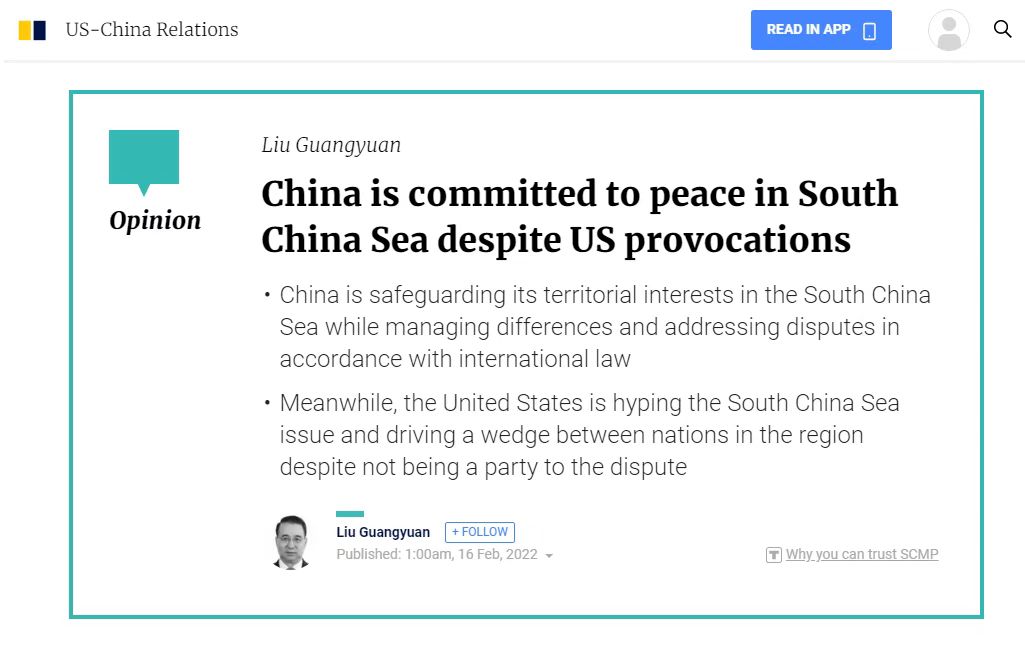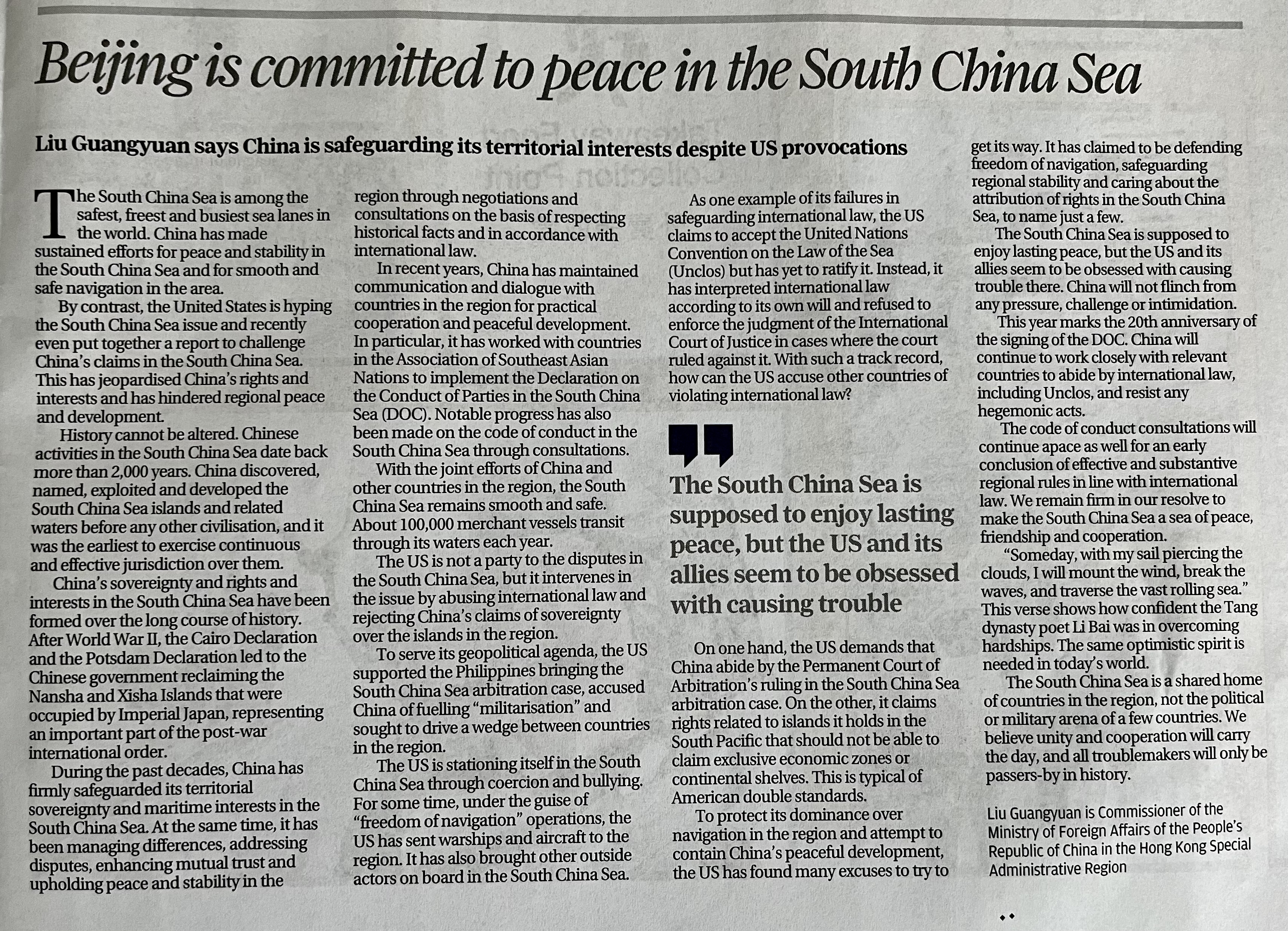2022年2月16日,外交部驻港公署刘光源特派员在《南华早报》发表题为《南海安宁不容域外黑手兴风作浪》的署名文章,旗帜鲜明宣介中方在南海问题上基本立场,揭批美打“南海牌”破坏国际法治、企图遏制中国发展的霸权行径,并结合“南海行为准则”磋商进展唱响中国与地区国家团结合作、共谋共建共赢南海的光明前景。文章当日亦在该报网页版刊登。全文如下:


南海安宁不容域外黑手兴风作浪
南海是世界上最安全、最自由、最繁忙的海上通道之一。中方一贯珍视南海和平稳定和航行通道的畅通安全并为之付出不懈努力。但长期来,美国不断在南海问题上挑拨离间、搬弄是非,近期还炮制所谓“海洋界限”报告诋毁中方在南海的权利主张,严重违背事实和法理,严重破坏国际法治,严重侵犯中方正当权益,严重阻碍地区和平与发展。
历史不容篡改,公道自在人心。中国在南海的活动已有2000多年的历史,不仅最早发现、命名和开发利用南海诸岛及相关海域,还最早开始并持续、和平、有效地进行管辖。中方在南海的主权和权益是在长期历史过程中形成的,具有充分历史和法理依据,并为中国历代政府所坚持。二战后中国政府依照《开罗宣言》和《波茨坦公告》规定,收复被日本非法侵占的南沙和西沙群岛,构成战后国际秩序的重要环节。大多数国家都公开承认南海诸岛是中国领土,日本等国出版的百科全书、年鉴和地图亦将南沙群岛等标属中国。相关历史均是铁的事实,白纸黑字不容歪曲!
几十年来,中方坚定维护在南海的领土主权和海洋权益,同时始终坚持在尊重历史事实的基础上,根据国际法,通过谈判协商管控分歧,解决争议,增进互信,维护南海和平稳定。近年来,中方与南海当事国保持沟通对话、推进务实合作、共谋和平开发,特别是与东盟国家全面有效落实《南海各方行为宣言》,积极推进“南海行为准则”磋商,取得重要进展。事实也证明,在包括中国在内地区国家共同努力下,南海一直保持着畅通安全,每年往来约10万艘商船,没有任何船只在南海航行受阻、安全受到威胁。
来说是非者,正是是非人。美国不是南海争议当事方,却企图打“南海牌”介入地区局势,频频歪曲滥用国际法,否认中方对南海诸岛的主权,一手导演南海仲裁案等政治闹剧,无端指责中方在南海实施“军事化”,蓄谋挑拨地区国家关系,服务一己地缘政治私利。然而,在南海搞胁迫、霸凌、军事化的正是美方自己!一个时期以来,美公然打着“航行自由”幌子跑来南海耀武扬威,动辄派出大规模舰机在域内挑衅滋事,非法闯入中国领海领空及岛礁邻近海空域,还肆意诱拉其他域外国家来南海“秀肌肉”“搅浑水”。多行不义必自毙,事实一再证明美方这些倒行逆施纯属自虐,损己不利人,更遭到地区国家和国际社会一致唾弃!
美自身是维护国际法的差等生,迄未加入《联合国海洋法公约》,还一向对国际规则合则用、不合则弃,拒不执行国际法院“军事和准军事活动”案等判决,有何资格摆着“裁判官”嘴脸拿公约对中国说三道四?如果根据所谓南海仲裁案的裁决提出的“标准”,美国的约翰斯顿岛、贾维斯岛、威克岛都无法被界定为岛屿,不能主张专属经济区和大陆架,但美方一边要求中方遵守非法裁决,另一边却心安理得主张上述小礁相关权利。这种赤裸裸的双重标准和强盗逻辑充分说明其捍卫“航行自由”是假,觊觎“航行霸权”是真;维护地区稳定是假,在地区兴风作浪是真;关心南海权利归属是假,企图遏制中国发展是真。
南海本无事,是美方在执意生事,但中方不信邪、不惧压、不怕事。今年是《南海各方行为宣言》签署20周年,中方愿与相关国家勠力同心,恪守《联合国海洋法公约》在内的国际法,坚决反对美方搅乱南海的霸权行径,并加快推进“南海行为准则”磋商,争取早日达成有效、富有实质内容、符合国际法的地区规则,共同把南海建设成和平之海、友谊之海、合作之海。
长风破浪会有时,直挂云帆济沧海。南海是地区国家共同家园,不是个别国家的政治军事秀场。团结合作的正能量终将勇立潮头,搅局捣乱的破坏者只会是匆匆过客,必将被时代洪流冲刷湮灭!
China is committed to peace in South China Sea despite US provocations
The South China Sea is among the safest, freest and busiest sea lanes in the world. China has made sustained efforts for peace and stability in the South China Sea and for smooth and safe navigation in the area.
By contrast, the United States is hyping the South China Sea issue and even put together a report titled “Limits in the Seas” to challenge China’s claims in the South China Sea. This has jeopardised China’s rights and interests and has hindered regional peace and development.
History cannot be altered and justice will prevail. Chinese activities in the South China Sea date back more than 2,000 years. China discovered, named, exploited and developed the South China Sea islands and related waters before any other civilisation, and it was the earliest to exercise continuous and effective jurisdiction over them.
China’s sovereignty and rights and interests in the South China Sea have been formed over the long course of history. After World War II, the Cairo Declaration and the Potsdam Declaration led to the Chinese government reclaiming the Nansha and Xisha Islands that were occupied by Imperial Japan, representing an important part of the post-war international order.
During the past decades, China has firmly safeguarded its territorial sovereignty and maritime interests in the South China Sea. At the same time, it has been managing differences, addressing disputes, enhancing mutual trust and upholding peace and stability in the region through negotiations and consultations on the basis of respecting historical facts and in accordance with international law.
In recent years, China has maintained communication and dialogue with countries in the region for practical cooperation and peaceful development. In particular, it has worked with countries in the Association of Southeast Asian Nations to implement the Declaration on the Conduct of Parties in the South China Sea (DOC). Notable progress has also been made on the Code of Conduct in the South China Sea through active consultations.
With the joint efforts of China and other countries in the region, the South China Sea remains smooth and safe. About 100,000 merchant vessels transit through its waters each year.
The United States is not a party to the disputes in the South China Sea, but it intervenes in the issue by abusing international law and rejecting China’s claims of sovereignty over the islands in the region. To serve its geopolitical agenda, the US supported the Philippines bringing the South China Sea arbitration case, accused China of fuelling “militarisation” and sought to drive a wedge between countries in the region.
The US is stationing itself in the South China Sea through coercion and bullying. For some time, under the guise of “freedom of navigation” operations, the US has sent warships and aircraft to the region. It also brought other outside actors on board in the South China Sea.
As one example of its failures in safeguarding international law, the US claims to accept the United Nations Convention on the Law of the Sea (UNCLOS) but has yet to ratify it. Instead, it has interpreted international law according to its own will and refused to enforce the judgment of the International Court of Justice in cases where the court ruled against it. With such a track record, how can the US accuse other countries of violating international law?
On one hand, the US demands that China abide by the Permanent Court of Arbitration’s ruling in the South China Sea arbitration case. On the other, it claims rights related to islands it holds in the South Pacific that should not be able to claim exclusive economic zones or continental shelves. This is typical of American double standards.
To protect its dominance over navigation in the region, provoke confrontation and attempt to contain China’s peaceful development, the US has found many excuses to try to get its way. To do so, it has claimed to be defending freedom of navigation, safeguarding regional stability and caring about the attribution of rights in the South China Sea, to name just a few.
The South China Sea is supposed to enjoy lasting peace, but the US and its allies seem to be obsessed with causing trouble there. China will not flinch from any pressure, challenge or intimidation.
This year marks the 20th anniversary of the signing of the DOC. China will continue to work closely with relevant countries to abide by international law, including UNCLOS, and push back against any hegemonic acts meant to disturb the South China Sea. The code of conduct consultations will continue apace as well for an early conclusion of effective and substantive regional rules in line with international law. We remain firm in our resolve to make the South China Sea a sea of peace, friendship and cooperation.
“Someday, with my sail piercing the clouds, I will mount the wind, break the waves, and traverse the vast rolling sea.” This verse shows how confident the Tang dynasty poet Li Bai was in overcoming hardships. The same optimistic spirit is needed in today’s world.
The South China Sea is a shared home of countries in the region, not a political or military arena of a few countries. We all believe unity and cooperation will carry the day, and all troublemakers will only be passers-by in history.